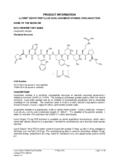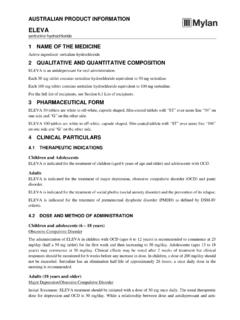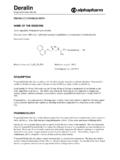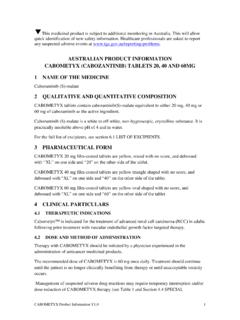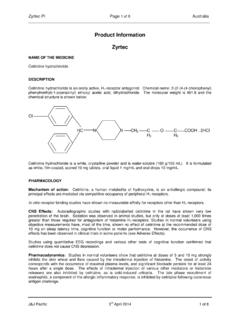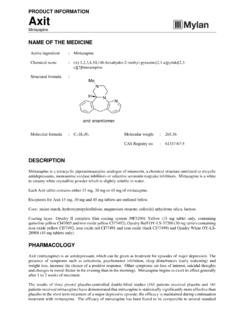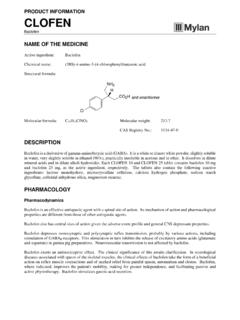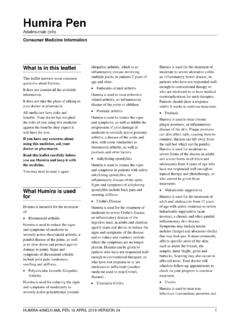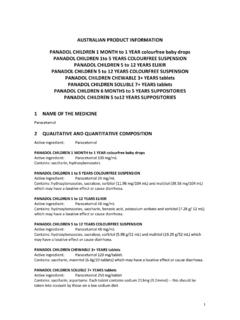Transcription of Aratac - Medicines
1 PRODUCT INFORMATION Aratac Amiodarone hydrochloride NAME OF THE MEDICINE Active ingredient : Amiodarone hydrochloride Chemical name : (2-n-butyl-3[4-(2-diethylaminoethoxy)-3, 5-diiodobenzoyl]benzofuran hydrochloride) Structural formula : Molecular formula : Molecular weight : CAS Registry no. : 199774-82-4 DESCRIPTION Amiodarone hydrochloride is a Class III antiarrhythmic agent. Amiodarone hydrochloride is a fine white crystalline powder. It is slightly soluble in water and is soluble in alcohol and chloroform. It is an amphiphilic compound and contains iodine in its formulation. Each 200 mg tablet of amiodarone contains approximately 75 mg organic iodine and, in the steady state, metabolism of 300 mg amiodarone yields 9 mg/day of iodine. Aratac 100 and Aratac 200 tablets contain 100 mg and 200 mg amiodarone hydrochloride, as the active ingredient, respectively.
2 The tablets also contain the following inactive ingredients: lactose monohydrate, microcrystalline cellulose, povidone, crospovidone, colloidal anhydrous silica, purified talc and magnesium stearate. PHARMACOLOGY Site and Mode of Action Amiodarone is a Class III antiarrhythmic agent prolonging the action potential duration and hence refractory period of atrial, nodal and ventricular tissues, thereby giving a very broad spectrum of activity. An increase in the refractory period of the atrial cells is a major contributing action to the control of atrial tachyarrhythmias. A reduction in the permeability of the atrioventricular node, both anterograde and retrograde, explains the efficacy of the drug in nodal tachycardias caused by re-entry through the atrioventricular node. Its action on ventricular arrhythmias is explained by a number of mechanisms.
3 The effect on the atrium and atrioventricular node results in a reduction in the frequency of stimuli reaching the ventricle thus giving the ventricular cell mass time to repolarise in cases where there has been desynchronisation of the refractory periods. Furthermore, a lengthening of the refractory period of the His-Purkinje system and ventricular contractile fibres reduces or prevents micro re-entry. Amiodarone increases coronary blood flow, decreases cardiac oxygen requirements without producing negative inotropic effects and also suppresses ectopic pacemakers, and this is particularly valuable in arrhythmias associated with ischaemic damage or angina pectoris. Aratac Product Information 2 The site and mode of action of amiodarone can be summarised in terms of its effect on myocardial electrophysiology: Myocardial Electrophysiology Sinus Node.
4 It decreases sinus automaticity by reducing the slow diastolic depolarisation gradient in the nodal cell. This is a direct effect and is not mediated through the sympathetic or parasympathetic system. Atrioventricular (A-V) Node. It reduces the speed of conduction and increases the refractory period of the atrioventricular node. His-Purkinje System. It increases the refractory period but does not modify the speed of conduction of the His-Purkinje system. Contractile Fibres. It increases the action potential but does not alter the rate of depolarisation of the atrial or ventricular myocardial cells; an effect that is more marked in the atria than the ventricles. Pharmacokinetics In general, pharmacokinetic data relating to amiodarone are incomplete. Absorption Amiodarone is incompletely and erratically absorbed following oral administration.
5 Absolute bioavailability ranges from 22 to 86% but there is extensive inter-subject variation. Metabolism First pass metabolism in the gut wall and/or in the liver may be a factor in determining the availability of the drug. Distribution An HPLC method is available for estimation of amiodarone plasma levels. However, the value of this is limited because the correlation of therapeutic effect and plasma level has not been established. Steady state plasma levels are generally around 1 to 2 g/mL, although inter-subject variations are common. Considerably higher values have been reported, especially subsequent to large single doses. Peak plasma concentrations of g/mL have been recorded following a single dose of 1600 mg and g/mL after a single dose of 800 mg. Steady state levels of g/mL and g/mL have been recorded after daily oral dosing in the range 800 to 1800 mg.
6 The half-life of amiodarone is long and with chronic oral dosing can be from 14 to 110 days but is usually in the range 14 to 59 days. The principal metabolite of amiodarone, which has been detected in the plasma and other tissues, is desethylamiodarone. This metabolite is reported to have a longer half-life than amiodarone ie. 10 hours after a single dose of amiodarone and 60 to 90 days after chronic dosing with amiodarone. The activity of this metabolite is not known. Amiodarone is highly protein bound and is thought to bind strongly to protein at concentrations of 10 g/mL. The apparent volume of distribution after oral (200 to 400 mg) amiodarone is L/kg. Amiodarone appears to accumulate in adipose tissue and in highly perfused organs (lung, bone marrow, adrenals, liver, pancreas, heart, spleen and kidney).
7 The concentration of amiodarone in packed red blood cells is approximately 60% of that in plasma. Excretion It is believed that most of the drug is excreted via the liver and gastrointestinal tract by biliary excretion. There may be some hepatic recirculation. Aratac Product Information 3 INDICATIONS Severe cases of tachyarrhythmias ( Wolff-Parkinson-White syndrome; supraventricular, nodal and ventricular tachycardias; atrial flutter and fibrillation; ventricular fibrillation) not responding to other therapy. Treatment should be initiated in hospital. It is recommended that the patient should be regularly monitored for possible toxicity ( thyroid function, chest X-ray, ophthalmological examination, liver function etc.) during the entire course of therapy and for several months after discontinuation. CONTRAINDICATIONS Known hypersensitivity to iodine or amiodarone or to any of the excipients.
8 Pregnancy and Lactation (see PRECAUTIONS - Use in Pregnancy and PRECAUTIONS - Use in Lactation). In patients in whom bradycardia or AV block is sufficient to cause syncope, patients with sick sinus syndrome (risk of sinus arrest) or with severe atroventricular conduction disorders, Aratac should only be used in conjunction with a pacemaker. Sinus bradycardia and sino-atrial heart block. Aratac is contraindicated in patients with evidence, or a history, of thyroid dysfunction. Combined therapy with drugs which may induce Torsades de Pointes (see INTERACTIONS WITH OTHER Medicines ). Hypotension, severe respiratory failure, cardiomyopathy, heart failure, circulatory collapse, severe arterial hypotension and bi- or tri-fascicular conduction disorders. PRECAUTIONS It is recommended to perform an ECG and serum potassium measurement before treatment initiation.
9 Caution should be exercised in case of hypotension, severe respiratory failure, uncompensated or severe heart failure. Thyroid Hormone Abnormalities As amiodarone may induce thyroid disorders (see ADVERSE EFFECTS), particularly in patients with personal or family history of thyroid disorders, clinical and biological monitoring [ultrasensitive TSH (usTSH) assay] is recommended before starting treatment, during treatment and for several months following treatment discontinuation. Serum usTSH levels should be measured when thyroid dysfunction is suspected. Severe cases, with clinical presentation of thyrotoxicosis, sometimes fatal, require emergency therapeutic management. Amiodarone contains iodine and thus may interfere with radio-iodine uptake. However, thyroid function tests (free-T3, free-T4, usTSH) remain interpretable.
10 Amiodarone inhibits peripheral conversion of thyroxine (T4) to triiodothyronine (T3) and may cause isolated biochemical changes (increase in serum free-T4, free-T3 being slightly decreased or even normal) in clinically euthyroid patients. There is no reason in such cases to discontinue amiodarone treatment. Hypothyroidism should be suspected if the following clinical signs, usually slight, occur: weight gain, cold intolerance, reduced activity, excessive bradycardia. The diagnosis is supported by a clear increase in serum usTSH. Euthyroidism is usually obtained within 1 to 3 months following the discontinuation of treatment. In life-threatening situations, amiodarone therapy can be continued, in combination with L-Thyroxine. The dose of L-Thyroxine is adjusted according to TSH levels. Hyperthyroidism Hyperthyroidism may occur during amiodarone treatment, or, up to several months after discontinuation.
